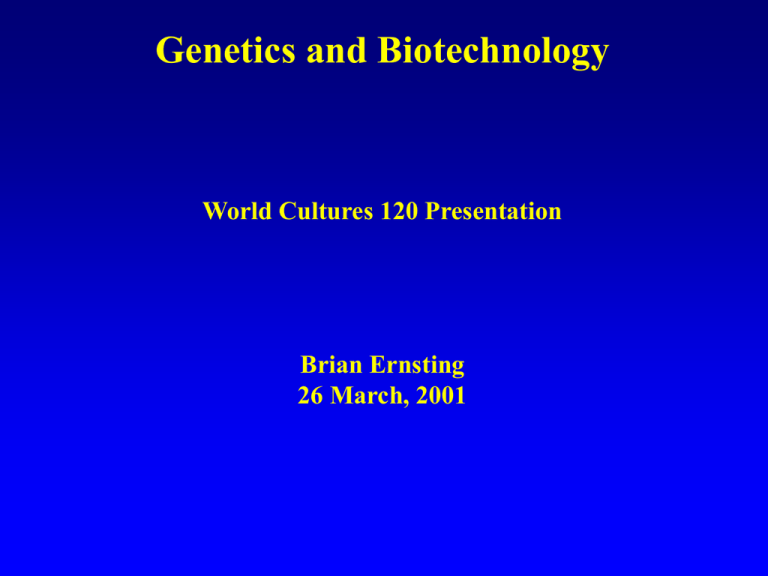Genetics and Biotechnology World Cultures 120 Presentation Brian Ernsting 26 March, 2001
advertisement

Genetics and Biotechnology World Cultures 120 Presentation Brian Ernsting 26 March, 2001 Goals 1. To put modern biology in context. 2. To understand a few of the basics of how genes work. 3. To think about the implications of biotechnology. The ability to understand and manipulate the software of life is the most important accomplishment of the biological sciences. Like the revolutions personified by Galileo and Darwin, the biological revolution changed the way science looks at the world. Unlike these revolutions, the twentieth-century biological revolution did not have to displace longstanding philosophical and theological explanations. Galileo Darwin Applied recently invented apparatus (the telescope) to answering scientific questions. Did not use specialized apparatus. Gained insight through meticulous observation and analysis of the natural world. Our understanding of genetics came from a combination of these two approaches. The Galilean approach is exemplified by the application of newly invented physical and chemical methods (radioactive tracers, X-ray crystallography) to answering biological questions. The Darwinian approach is personified by Gregor Mendel and his model of inheritance. Gregor Mendel was an Austrian monk trained in probability mathematics and plant breeding. He used pea plants as a model experimental system. In these experiments, he examined the inheritance of characters like flower color and seed shape by mating plants and observing the offspring. Mendel followed heritable characters for three generations. Mendel’s results refuted the blending hypothesis. He proposed a particulate theory of inheritance where characters are determined by genes (recipes for a character) that come in different versions (alleles). •Each parent has two alleles. •Gametes contain only one allele. •Offspring have two alleles - one allele from each parent. •When both alleles are present, the dominant allele determines appearance. •Gametes contain only one allele. •Offspring have two alleles - one allele from each parent. •When both alleles are present, the dominant allele determines appearance. •This leads to a 3:1 ratio of offspring. Most interesting characters are influenced not by one or two genes, but by dozens or hundreds. In this example, alleles at three loci control skin color. Environmental factors can also influence these polyfactorial characters. The distribution shown here is characteristic of polyfactorial characters. These characters vary continuously, rather than in a few discrete states. Their genetic component is still inherited in a particulate manner. Although Darwin had access to Mendel’s work, he did not read it, and it was left to later investigators to unify Mendelian genetics with evolution. The rediscovery and confirmation of Mendelian genetics in the 1930s strengthened the case for evolution and made mathematical models of evolutionary change possible. Evolution, in turn, provides the answers for genetic questions. In addition to being genetically based, the modern synthesis of genetics and evolution also allows for evolution by mechanisms other than natural selection. Theodosius Dobzhansky: "Nothing in biology makes sense except in the light of evolution." The combined power of evolution and Mendelian genetics to explain the natural world stimulated interest in the physical nature of the gene. Although most biologists originally believed that protein was the genetic was the genetic material, experimental evidence pointed to DNA. When Watson and Crick published the structure of DNA, many of the functional characteristics became apparent. The complementary nature of a DNA duplex allows each strand to serve as the template for the synthesis of its partner. DNA, by itself, is biologically inert. It is analogous to a recipe, or to computer software. The proteins that are the products of DNA recipes carry out the processes of life. In general, all living cells have the hardware to make protein from any DNA recipe. A deep understanding of the process of gene expression allows biologists to make directed changes to organisms. Examples: •Bacteria that express human insulin •Soybeans that are resistant to herbicides •Cotton plants that manufacture their own pesticides •Viral genes inserted into cancer cells to make them more susceptible to chemotherapy •Goats that secrete pharmaceuticals in their milk In addition to making directed changes, biotechnology allows us to find out about species, populations or individuals. •How closely related are two species? •How much genetic diversity is present in a given population? •How are individuals related? •Which individual donated this sample? •To which diseases is this individual predisposed? These techniques and questions represent the current state of biology. Future progress will center on understanding the function and expression of gene families and networks, rather than isolated genes. Genome —————> Proteome —————> Organism Cookbook ———————————> What’s for Lunch? In the early part of the 20th century, progress in genetics was instrumental in supporting and refining our understanding of evolution. In the early part of the 21st century, evolution guides the interpretation and analysis of genomic data. Comparing organisms at the level of the genome allows us to gain insight into the function of conserved sequences and to see evolution in action in variable regions. Automated data collection and analysis are necessary to perceive patterns in genomic and proteomic data. Recap 1. The science of genetics both informs and employs an evolutionary perspective to understand the software of life. Recent advances in genetics depend heavily on specialized apparatus, from tunable X-ray sources to the most sophisticated robotics and computers. 2. The revolution in molecular genetics is ongoing, moving from analysis and manipulation of single genes and proteins to understanding how networks of genes cooperate to produce organisms. 3. Our current understanding of genetics and biochemistry allows us to modify existing organisms in a directed way. Progress being made now will allow much more sophisticated design of custom organisms. Non-biological questions: 1. Privacy - what if the results of a genetic test have important implications for family members? 2. Third-party interests - should employers and insurers have access to genetic information? 3. Intellectual property - who owns the information in the genome? 4. Human genetic manipulation - should directed or selective manipulation of human genetics be encouraged, allowed, or forbidden?



